Funnier sheep than Britain

We use Google Cloud Translation Services. Google requires we provide the following disclaimer relating to use of this service:
This service may contain translations powered by Google. Google disclaims all warranties related to the translations, expressed or implied, including any warranties of accuracy, reliability, and any implied warranties of merchantability, fitness for a particular purpose, and noninfringement.

Highlights
- In Lake Naunje of Machhapuchhre, there is only one sheep born. There are five hundred sheep in the barn. Buccaneers and sheep grazing on khark are hard to protect against cold, leopards and bears. Himalayan Vedigoth culture is in crisis, the sons are calling Britain, but Surje is happy with the Vedigoth of the Himalayas.
- There are not only sheep in the jewel sheepfolds of the Himalayas, there are also some intriguing stories of 'forest beasts' i.e. creatures that look like humans. Gothmuli says - the forest scarecrow comes from time to time and he is afraid to stay alone in the cowshed.



Surje's home is Vedigoth under Machhapuchhre Himal. There are more than five hundred sheep and goats in his sheepfold. Ubhouli starts on Sripanchami, after Sripanchami Surje takes Goth from the village to the lake. They graze on buccaneers and buffaloes. As the heat rises, the shed moves upward. They deliver to the barn until 9:00.

Udhauli starts from Sankranti. By feeding green grass, herbs, the cow starts to fall. Goth descends towards the village as it gets colder.
Following the same herd of Surje, we were also going uphill towards Machhapuchhre Himal through the sheep walking path.
If I had to choose between yoga, meditation and hiking, my choice would be hiking. Climbing uphill is no less than doing yoga. It's like meditating, the experience of reaching the top of a mountain and looking around. If there was no household life, he spent his days walking. Like Tony Hagan measured Nepal with a shovel to know the geography. Like Tom Tercich spent 7 years and 49 days walking 38 countries on 6 continents to find the meaning of life.

Annapurna Conservation Area Project (ACAP) chief Ravin Kadaria proposed to go on a week-long exploration of the Tinshir trekking route. How to refuse such a beautiful offer? After a long time, I went for a walk.
After reaching the valley formed by the Annapurna Ice Range by cutting the left side of Machhapuchhre, the sight of Seti sitting on the head of Gandaki moved in the mind. As much as it is fun to see the mountains from the other side, it is more exciting to reach the bottom of the mountains. Who wouldn't want to reach Machhapuchchre, which is called the 'Kumari Himal'? Instead, why is the fish tail called 'Kumari'? Why was it not called 'Kumar'! Why do some people argue that the fish tail should be kept as a 'virgin'? After all, even if you climb or not, the dignity of the fishtail will not decrease. Mountains have no gender.
2069 The Kharapani market, which collapsed due to the unseasonal flood in Seti on 23 Baisakh, has not recovered yet. On Saturday, 28 people were swept away in the flood, including students who had gone for a forest dinner, locals who were diving in the hot water, foreign tourists who were visiting, traders who were doing business, and laborers who were moving sand. 30 people went missing. The avalanche that fell from Annapurna 4 caused unimaginable damage when the lake formed by the damming of Seti burst suddenly.
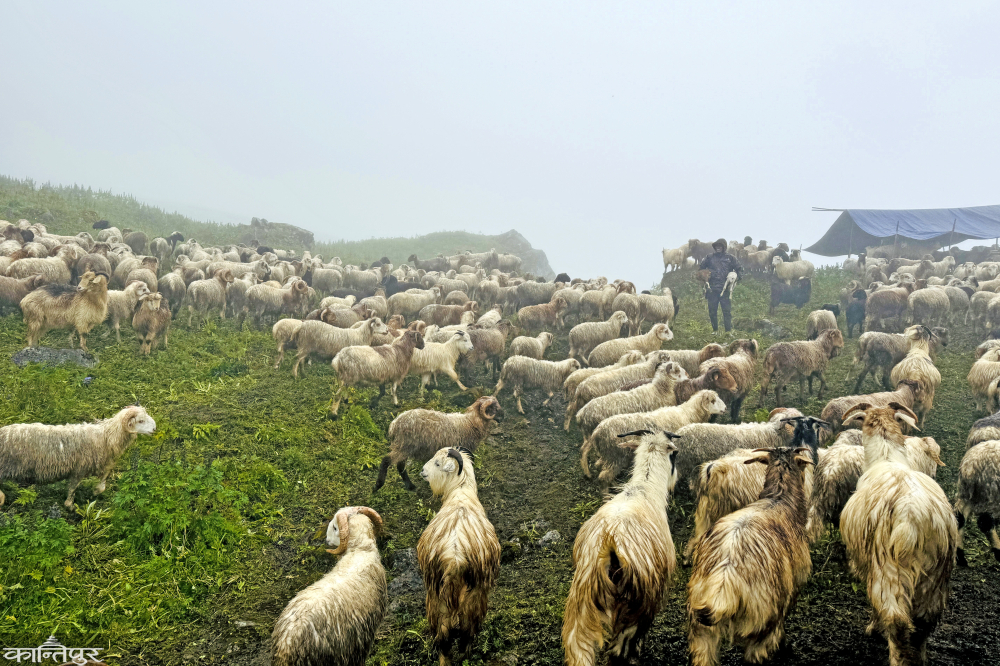
On 30th of July, Jeep reached Kharpani in one hour from Pokhara. ACAP sub-engineer Ramji Acharya was with him. After entering Machhapuchhre Rural Municipality through Lamachaur, Purunchaur, Annapurna conservation area started. Ranger Shakti Paudel of Area Protection Office Lwang joined from Bhurjungkhola Checkpost of ACAP. The destination of the first day was Mirsa village. We climbed uphill from Kharpani to reach Mirsa. Since the unpaved road has reached the village, the locals have stopped walking on the old road. The cobbled path was slippery. Mirsa was reached in an hour after climbing Seti to the right.
We stepped into a house with a large courtyard, splashing through the stone-printed door. The long stalks, the ears of corn hanging gracefully under the stone lintel, made the house attractive. Homegrown Surje Gurung gave a loud welcome. The responsibility of taking us to Tinshir was on his shoulders. At the village level of Savik, ACAP has formed a conservation area management committee by including local people. The former Machhapuchhre village has now become ward number 1 of Machhapuchhre rural municipality. Surje Gurung is the Chairman of Conservation Area Management Committee, Machhapuchhre. Owner of the only sheepfold in Machhapuchhre. He prefers to call himself a 'Shepherd'.
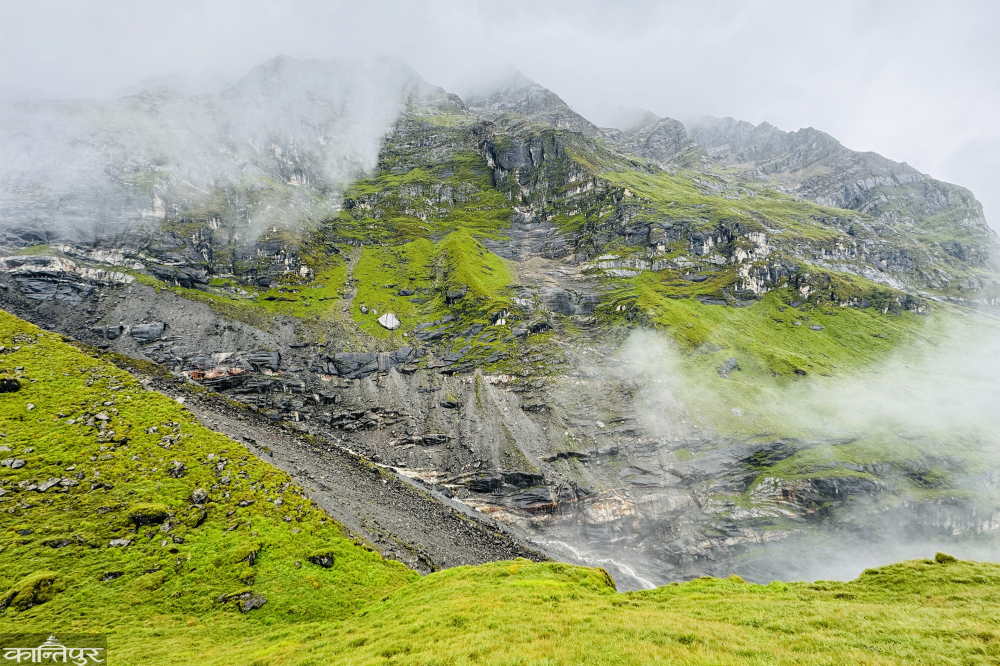
The team to reach Tinshir was a local guide, a porter and a cook. A team of fifteen was prepared. Being a 'camping trek', tents, sleeping bags, gas, food, etc., were heavily packed in the evening. The next morning's bright sun, blue sky indicated that the weather would be clear. Some relief came from the worry that the rain would make the journey difficult. Surje Dai's sheepfold was at the foot of the fish tail. In the winter, the basi fall shed is kept in the lake during the dry season. We had to walk, the way sheep walk. Follow the footsteps of the sheep.
Mirsa's ups and downs started from the time he left the village. Sankhuwasabha had three young men from Silichong as porters – Sandeep, Ramkeshar and Samrat Rai. Among them, 19-year-old Sandeep came to carry heavy loads for the first time. He passed his class 12 exam and studied language to go to Korea. One number did not reach the exam. He had come to carry heavy loads with the thought of being able to travel and earn. It was difficult for him to climb uphill with a heavy load. Swap heavily with another friend. After wiping the stream of sweat, he let out a sigh, 'Now I will study hard.' By then it had started to rain lightly. The rain did not wet the body. The next morning, the mountains opened up and killed the fatigue of the previous day. The combination of green hills, blue sky, white mountains and cool breeze really gave as much energy as one can get from one hour of meditation.
Now Khumaidanda has become a trendy destination. From Pokhara, one can reach Khumaidanda in one day through Ghachok, Tuse, Saripakha of Machhapuchhre rural municipality. Locals have named it 'Great Machhapuchhre Trail'. Khumai is an excellent destination for sightseeing of Machhapuchhre, Annapurna snow range, Dhaulagiri, Pokhara and surrounding areas. There is a heavy presence of domestic tourists in Khumai during the season of snowfall and flowering of gourds. There are 7 hotels in Khumai. A hotel is under construction.
We started the journey again from Khumaidanda and reached Korchon (3690 m.). In the early morning, the sight of the yellow rays of the sun on the white mountains looks very charming. There are currently two hotels in Korcho. Another option is to reach Korchon via Saitighat, Mesram in Lwanghalel. This trek is popularly known as Machhapuchhre Model Trek.
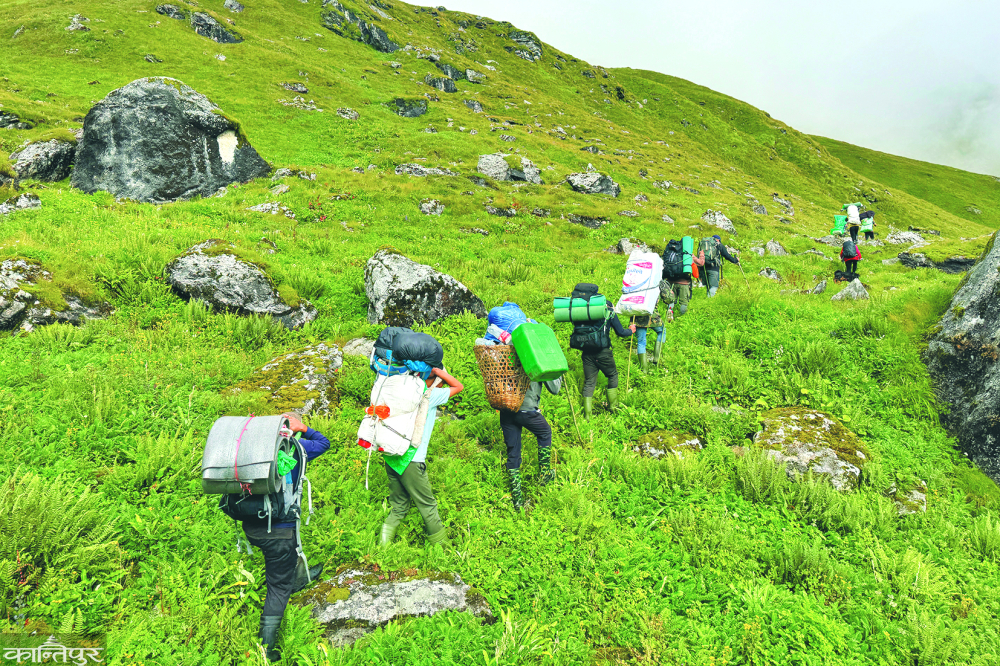
The journey from Korchos to the north was now up and down. The road was muddy due to rain. Hinku had to climb up on all fours. Even so, the porter is ahead, we are behind. Pansyo Deurali (4190 m.) was reached after crossing the road with only two steps over the landslide. Surje Dai said that today the difficult path is that much. He looked back the way he had come. The mist was visible only a little below. If the weather was open, it would have rained down to Mardi river. The
was brought back from Vedigoth with Surje Dai, Thople. Friends more, dogs less. When he came from the sheepfold to the village and when he climbed the cowshed from the village, he used to go back and forth together. Out of the 4 sheep-watching dogs, Thople Surje Dai's was special. The path we walked was bear habitat. Surje Dai pointed out a plant that the bear might have just eaten. Bears only attack when there is a child with them. There was even a few drops.
After a day's walk, Bunga (4110 m.) pitched a tent and stayed at Khark, while Thople kept watch all night. The next morning, looking at Bunga Khark, the fish tail was now visible only a few kilometers away. In an instant it was covered by clouds. I am still remembering Lochan Rizal's song - 'If the clouds are removed from that mountain, the colors of the rainbow will be visible and...!' Although it was shorter than the previous two days, the road was no less dangerous. Surje Dai pointed out herbs along the way, similar in appearance to Niramsi's medicine and poison. White flowering medicine, blue flowering poison. He worries about protecting the sheep from this poison. He introduced herbs like jatamsi, kudki, sunpati, maramul, white and black bhootkesha. After walking half way, two more dogs of the sheep came to welcome us. Seeing Kalu and Bhote, Thople wagged his tail. They teamed up with Surje Dai.

Sheep found at Naunje (4320 m.). On that day, our team stayed at Nainsa Bagar where water flows from Mardi Himal. Khana Khaivari Surje dai, I, our local guide Man Bahadur Pun and nephew Nirmal Gurung dai stayed in Vedigoth. He opened the secret of the shepherd's life in the shed.
In the lake of Machhapuchhre, there used to be sheep from villages like Ghachok, Chaur, Khadarjung, Rivan. Everyone had their own expenses. Surje Dai had a sheep from his childhood. Villagers also raised sheep collectively. During his father's time, he used to skip school, but he used to go to Vedigoth. While studying 10th grade at Pokhara's Multipurpose High School (now National High School), he joined the British Army. But thrown in medical. He returned to the village and started living in the shed. In 2045, when he was 21 years old, he entered the tourism sector through a friend. He got a job at Himalaya Adventure in Kathmandu. Gora's helper who went on a "camping trek" reached the rank of Sardar through Sherpa.
At that time, the trek started from Tundikhel in Pokhara and went to Begnastal through Hemja, Lahachok, Dhiprang, Kharpani, Changlung, Ghalekhark, Nyaulikhark, Parche, Sikles, Swata, Lamakhet, Bhainse, Thangkot. There was no motorway in this area at that time. With tourists, he has reached Ghandruk, Ghorepani in Myagdi, Khair-Khopra, Dharche in Gorkha, Langtang area, Panchpokhri, Kanchenjunga, Everest base camp.
After spending seven and a half years in the tourism industry, he reached Taiwan through a broker. In 9 months, the local police caught him and sent him back. The process of returning to Nepal and going to Hong Kong and Europe was also unsuccessful. His mother passed away in 2062. Father was old. He felt that he had to take responsibility for the house. Returned to the village and started tending the cowshed. Sheep, goats, dogs became his friends now. Vedigoth under the mountains became his home.
There is no need to buy and feed sheep and goats except salt from the market. The shed has four employees. 70-year-old Chandra Bahadur Pun of Ghachok has been working as a radish for 7 years. In the absence of Surje Dai, Chandra Bahadur runs the cowshed. The remaining three are workers from Dhading. Mooli gets 1 lakh 20 thousand rupees annually. He also has 50 sheep in his name. The second root gets Rs 75,000 and the remaining two get Rs 60,000-60,000. Three people have 15 sheep each. Ration water is filled by the herdsmen. "It is difficult to find people who can stay and work in such a place," said Surje Dai about the difficulty of keeping a shed. I have not been able to leave the tradition of Baubaja.'
The market demand has changed before and now in sheep farming. By the time he managed the sheepfold, the first requirement was to weave radii, pakhi from sheep's wool. Second is the need for fertilizers for farming. And, only in the third, salt, oil and clothes were sold for meat. Now it is the opposite. His sheep are mostly sold for meat. During Dasain, he cannot fulfill the demand. A year ago, after paying the money, they say, 'We don't keep the sheep'. There are no people who weave radii and pakhi like before. They used to come from Kathmandu to buy wool, that too has been closed,'' he said. There are no people in the village, the fields are barren.'' Since selling more for meat, his income has also increased. The wool has been piled up at home for a year without being sold.
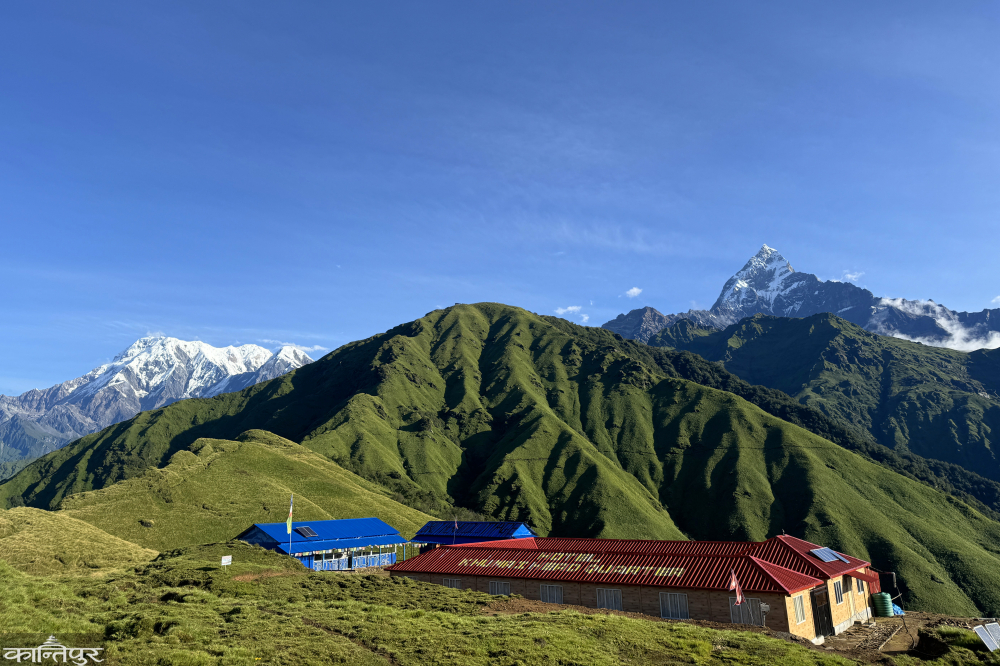
Among his three sons, Milo Ashish and youngest Ashok have joined the British Army. The eldest son Dhan Bahadur does business in Pokhara. His sons advise him to leave the barn and live in Pokhara. Two sons have called Britain. He did not want to leave the barn. "My heart doesn't want to leave a place like this heaven," he said at the age of 57.
From now on, he is worried about who will take care of the lamb after him. "Vedigoth is the jewel of the Himalayan region," he said, pointing to the radish of the barn, "They have cultivated it." It's difficult in a place where it rains like this. He sells about 60-70 sheep during Dasain. According to the current market price, one sheep costs 40 to 60 thousand rupees.
Mooli Chandra Bahadur of Goth has many experiences after spending seven years in a sheepfold. Sheep should be protected from cold, leopard and bear. They are not afraid of these animals, but they sometimes get angry with those who come to visit them. While sitting in the cowshed, he narrated the story of 'Vanko Bhyawan' i.e. the thirsty genie. Parar he considered it like a black sheep sitting outside the sheepfold in Naunje. Seeing this, he called. Something came walking from there. Even the dog refused to bark. As he got closer, he saw a black man. His words did not come out. The thing that looked like a human rose from the surroundings. He said that he was afraid to stay alone in the barn because the forest scarecrows would come from time to time.
seemed to me to be something more than a craving. That's all there is in the secret! Or is there any animal that looks like a person in the mountains? It is not unheard of that the people of the Himalayas fought with the Yeti. Tony Hagon mentions the context of meeting Yati's steps in his book, Kaski and Lamjung. Her book 'Bilding Bridge to the Third World, the draft of the geographical survey that has been in Nepal, a geographical survey of Nepal. & NBSP;
argued that everyone in the sheep lived in the forest, frightening or ghost. Smoke inside the barn became ukusmung.

had to set foot on the next day. Fisheries are in valleys built by the smell of smell and annored third-fourth mountain, three glands. The water coming from the three gates makes Siti Girkaki. More than half of my fishing is that it has reached the hunter, or the local powder displays with Dharmberby. It was our goal to reach three sides of the earth. & Nbsp;
did not rely on the weather. The water is being stopped, resentment. Not in the sun for two days. In the evening, the weather was given a chance to see the heart light openly. Mircai, a neighboring village, who came to Three Guide and arrived at three hides, was withdrawal. The guide and the Geriya team returned to the landslide that flowed to the landslide that flowed in the afternoon. They said they can reach the lands and reach three. & Nbsp; The Nenua takes two days from Bagar to reach
three. The Nanua should reach the Ranchiharkhi or Annapurna of the Hill (about 5,000 meters) by printing some of the parts of the mountains and remains in the Nenakhirk or Annapurna). The next day begins to reach Annapurni hill or Raniferr. & Nbsp; The Mind Bahadare, who reached three decades ago, remember that there was no Dangdunge. 'There was a snow ice first. We went to walk on the ice, "he said. ' Even before that, two years later, the Gandaki's association, the Gandaki team of Nepal, came to the pursuit of three. The team had returned to hide the treasures opened the eye opened the eye opened. Two days ago, a team of fish in the village before we arrive and returned from Rape. & Nbsp;
was passed on the bridge of the Surge's night at the night. It was still on the other hand concern that the weather could not be able to reach the weather. The tent we have had old & nbsp; waters were leaking. Going up, the loud air tent could come into case of noise. Surj Dai of Surj Brother thought of a lot of morning in the morning. There was some difficult to rescue at that area. The helicopter could come because of lack of weathercomings and communication. It took three days to bring Pokhaly. They did not want to risk their teams. In order to walk, he told the team that 'This happened. Argument not to take risks unpredictable. Some of the decision was disappointed by some who were in Tim. We stayed in the street that day. Some friends reached Masco Hycade (4700 m.). If the weather opens the weather, the fish would not have nothing but the winds on us. The robp, the Munal appeared there. The herd of the strife is running a herd of herd. & NBSP;
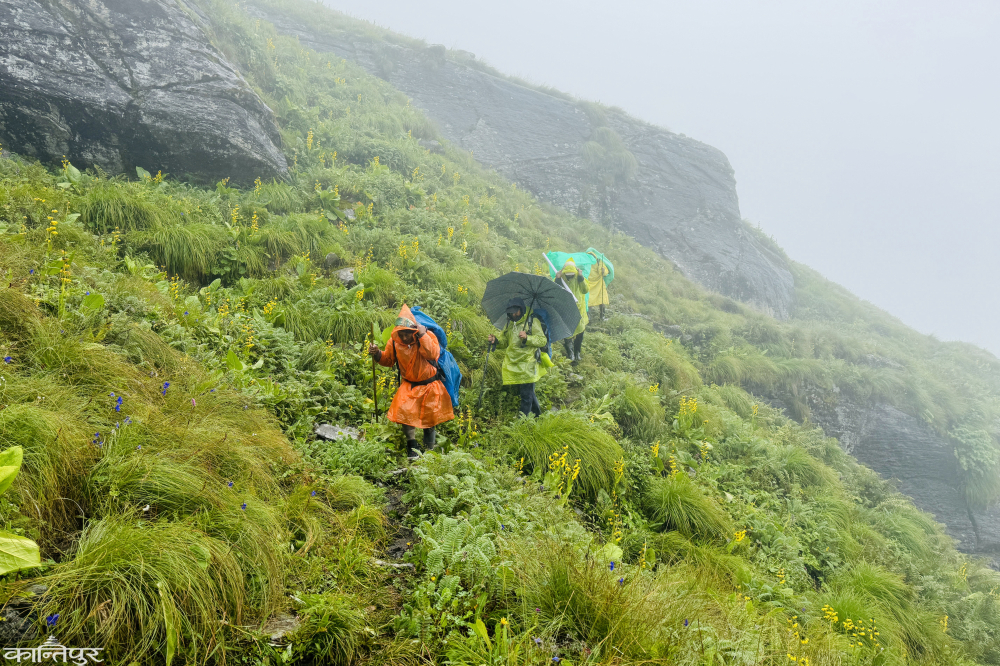
Nugaj, Barge, Barley, back through the pipre. Piparko is the two buffalo curtains of the crowth. Our Guide's son was handled with Bhandhias. Pipark's Pipper Lake on Mount. It is believed that the birds would tip out by the birds as soon as the leaves fall out of the lake. Since Pileper's pipers does not listen to water on Pinear, Chain, Praiper is not sleeve to drink water and birds of birds. Even for the observation of the birds including Kalius species, the birds and registers, including birds, including birds, birds and nbsp. & Nbsp;
arrived from the piles the next day, the plants arrived in the village after placing them from the piles. Pipulaies from the bunga, from the pinea, were not thrown into the shores on a shoe on a shooting mud. Upon arriving, he was finished human form. Beginned from the grass and arrived Mirusa. & Nbsp; The purpose of
trip is not just a look at nature, people will read. The campaign to reach three three is not successful. However, this tradition took care of the trustbox. The passenger's story had the opportunity to know. Ramji Rai, a young body, who has been abusive, who has been abused by the same clean sirgi, and friends, who accompanied the same clean sir, in his head, has been difficult to carry on the same clean food, hellings, and friends, young people, who have been involved in the eyes of the mind, and the scissors of reading, with all that happened with all the teams of how to read heavily. Still feels on the journey. & Nbsp yet. & Nbsp;
time will surely come to see oxider, dear threesir. & nbsp;


 प्रकाशित : भाद्र १५, २०८१ १०:४९
प्रकाशित : भाद्र १५, २०८१ १०:४९

 २९.१२°C काठमाडौं
२९.१२°C काठमाडौं











